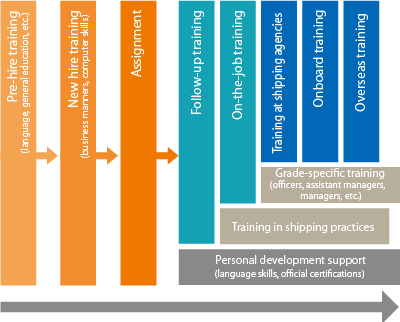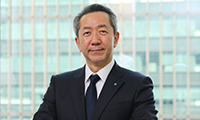Basic Policy on Human Resources
The Company's human resources are based on the premise that our employees, both administrative and technical, are hired for the long term. And in accordance with Japan's Law on Securing Equal Opportunity and Treatment between Men and Women in Employment, employment is based solely on the abilities and aptitude of each person, and the growth of employees is encouraged by the Company's training system.
The percentage of women that make up our workforce is gradually rising. While there are no women holding executive positions at this point in time, women account for 40% of all new graduates hired for career-track positions over the past three years. And when considering the various life events that people experience, we believe in the importance of creating a workplace environment favorable to ongoing employment.
We are undertaking this task by using a variety of effective means, such as IT-based approaches to improve operational efficiency and information sharing.
D&I Action Guideline
Among the issues related to ESG, society strongly requires us to ensure diversity in human resources. The Company's approach to this issue has been clearly defined in the Diversity & Inclusion (D&I) Action Guideline and Plan. Based on this guideline, we will continue and strengthen initiatives as detailed below.
D&I Action Guideline
Workstyle Reforms ・Health Management
Promoting the Active Participation of Women
Goal
By fiscal year 2025, we will increase the number of female executive employees from the current zero to at least one, with a goal of attaining two or more. (The number of women in career-track positions as of April 2021 is 11 employees.)
Our goal for 2030 is to have at least three female executives, with the ultimate goal of having five or more.
Specific initiatives
(1) Increase the number of recruited women
- Strengthen efforts to increase the recruitment of women, including for career-track positions.
- Encourage those in semi-career track and administrative positions to transfer to career-track positions.
(2) Measures to prevent turnover
- Improve the system to prevent resignations due to life events, such as by enhancing childcare and nursing care leave and expanding remote working (including from places other than their homes), etc.
- Host trainings and seminars to support women's career development.
(3) Job allocations and training programs that will lead to appointments in executive positions
- Conduct advanced training in anticipation of potential life events (overseas training, etc.).
(4) Executive training and building understanding within the workplace
- Educate the executives in order to create an atmosphere throughout the entire workplace that makes it easier for women to participate actively
Employment of Older Aged and Disabled Persons
Goal
(1) Employment of older aged persons
In April 2021, the Act on Stabilization of Employment of Elderly Persons was amended to require companies to make an effort to provide employment opportunities to their employees until age 70. In response to this, the Company began by first working toward changing the retirement age to 65, while continuing to keep a close watch on our obligations and social trends.
(2) Employment of disabled persons
As of March 2023, the Company currently fulfills our obligation to meet the employment ratio of disabled persons, but we will continue to keep a close watch over trends in legal amendments and will strive in our efforts with the goal of exceeding the legally required employment rate.
Personnel Development
One element of our management philosophy is to nurture and mobilize employee abilities. Specifically, we provide training tailored to the rank and the requirements of employees so that all of them can become a professional in the field of international shipping. On-the-job training (OJT) is at the core of this system which includes training for new employees, training in shipping practices, training at shipping agencies, onboard training, overseas training, and grade-specific and job-specific education.
After joining the Company, seamen work at sea for three to four years and then cycle between shore and sea work in intervals of roughly three to five years. Through these transfers, they gather experience as seamen and of shore-based management, developing as independent officers with broad perspectives. For non-Japanese seamen, we have a promotion support system and skill improvement training programs that include pre-boarding seminars both in the country of recruitment and in Tokyo, classroom training, assistance in obtaining advanced marine certifications, and OJT.

Personnel System
Our personnel system was introduced in fiscal year 2001 to accurately reflect the assessment results of the employees' abilities, motivation, and performance toward their promotions and advancement, and we have been striving to gain an understanding of the employees' current situation and working to develop their abilities toward their future, while providing fair compensations for their performance. Now that more than 20 years have passed, changes in our business environment, such as advances in environmental and DX technologies and the heightened awareness toward sustainability, have made it imperative that we implement strategic investments in areas that have high sustainability and growth opportunities, and to establish a human resources management system that will enable us to execute such activities. Accordingly, our personnel system is currently being reviewed. Our aim is to create a workplace environment where employees feel psychologically safe enough to respond to change in a positive frame of mind, are encouraged to take on challenges, and are able to work for a long period of time with a sense of reassurance.


